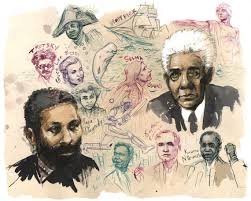Currently under
construction.
We're adding features,
and making the site
available on phones.
Bear with us...
A few things are working.
Try them out
Currently under
construction.
We're adding features,
and making the site
available on phones.
Bear with us...
A few things are working.
Try them out

Stuart Hall Interviews CLR James

From a Lost Tape featured in the Dec 21, 2024 New York Review of Books: “James and Hall both resolved to think through race and class together, showing how Marx could be articulated with analysts of colonialism and empire such as Garvey, Fanon, and W.E.B. Du Bois: as Hall famously wrote in Policing the Crisis (1978), “Race is the modality in which class is lived.” In The Black Jacobins (1938), James showed that the ideals of the French Revolution were realized in Port-au-Prince before they were realized in Paris. His preface to the book’s first edition adapts Marx: “Great men make history, but only such history as it is possible for them to make. Their freedom of achievement is limited by the necessities of their environment…”

The Stuart Hall Foundation
Home of many videos and commentaries on the founder of cultural studies. Access Here

I should have known Ken Grossinger would burst my bubble, in the best way. Ken has worked at the beating heart of movements for social change for decades, so I knew his new book, Art Works: How Organizers and Artists Are Creating a Better World Together (2023) would be rich with movement stories. And since I already fashioned myself one of those enlightened organizers who knows a thing or two about how to use art and music in campaigns and direct actions, I assumed this would be a stroll down memory lane.
But when I read the book, I woke up: I quickly realized Grossinger is up to something great and new here. He wants to challenge us all to be more creative, so we can more effectively craft the conditions for social change. Grossinger has the experience to grasp, in ways that few of us can, how art and organizing make each other more the sum of their parts. He now wants more of us to benefit from what he has learned. Read full article
Hip Hop And The Conditions That Gave Rise To A Cultural Movement

 E. P Thompson on Social Change
E. P Thompson on Social Change
Three lectures by the renowned E.P. Thompson in March 1977 on Models of Social Change, organized by Alan Macfarlane, dealing with the economy, social structure and ideology
Eight 8-minute videos entitled ‘Cultural Critcism and Transformation,’ where bell hooks covers a range of themes, from Madonna to Rap Music

Frank Sinatra, the Left and the US Popular Front
A 25 page article from Science & Society, 2002, by Gerald Meyer, explores the little-known history of the popular singer and his contributions to the left as a young man. Sinatra played an active role in a score of Popular Front organizations. In contrast to most other celebrity leftists, he also actively fought against racism and intolerance by speaking widely, including at high schools where racial incidents had occurred. Vicious red-baiting contributed to an astounding downward spiral in his career, and caused him to distance himself from the left. Access Here

Guy Debord: Society and Spectacle
“The spectacle is not a collection of images,” Debord writes, “rather, it is a social relationship between people that is mediated by images.”In his analysis of the spectacular society, Debord notes that quality of life is impoverished with such lack of authenticity, human perceptions are affected, and there’s also a degradation of knowledge, with the hindering of critical thought. Debord analyzes the use of knowledge to assuage reality: the spectacle obfuscates the past, imploding it with the future into an undifferentiated mass, a type of never-ending present; in this way the spectacle prevents individuals from realizing that the society of spectacle is only a moment in history, one that can be overturned through revolution. 90 minutes of film.
Stuart Hall on Race as a Constructed ‘ Floating Signifier’
Seven 10 minutes videos by the founder of cultural studies. Arguing against the biological interpretation of racial difference, Hall asks us to pay close attention to the cultural processes by which the visible differences of appearance come to stand for natural or biological properties of human beings. Drawing upon the work of writers such as Frantz Fanon, he shows how race is a “discursive construct” and, because its meaning is never fixed, can be described as a “floating signifier.”
The Letters of Rosa Luxemburg: A Reading
Acclaimed actress Kathleen Chalfant performs a selection of Rosa Luxemburg’s letters on the anniversary of her assassination. 55 Minute Video. The event took place at the official opening of the Rosa Luxemburg Stiftung New York Office, November 2012. For more information, visit www.rosalux-nyc.org. Introduction by Albert Scharenberg, Co-executive director of the Rosa Luxemburg Stiftung New York Office.
Sister Rosetta Tharpe, the Godmother of Rock and Roll
This one-hour documentary re-examines a piece of U.S. culture, highlighting the intersection of sex, race, and several trends in music. Sister Rosetta Tharpe (March 20, 1915 – October 9, 1973) was an American singer, songwriter, guitarist and recording artist. A pioneer of 20th-century music, Tharpe attained great popularity in the 1930s and 1940s with her gospel recordings that were a mixture of spiritual lyrics and early rock and roll accompaniment. As the first recording artist to impact the music charts with spiritual recordings, Tharpe became the first superstar of gospel music and became known as “the original soul sister”. She was an early influence on iconic figures such as Elvis Presley, Jerry Lee Lewis, Little Richard and Johnny Cash. Access Here

THE BATTLE OF RUSSIA: POPULAR FRONT IN FILM 105 minutes long, this is the fifth film of Frank Capra’s Why We Fight propaganda film series, and the longest film of the series. The film begins with an overview of previous failed attempts to conquer Russia: by the Teutonic Knights in 1242 (footage from Sergei Eisenstein’s film Alexander Nevsky is used here), by Charles XII of Sweden in 1704 (footage from Vladimir Petrov’s film Peter the First), by Napoleon I in 1812, and by Germany in World War II. The vast natural resources of the Soviet Union are then described, showing why the land is such a hot prize for conquerors. To give a positive impression of the Soviet Union to the American audience, the country’s ethnic diversity is covered in detail. Later on, elements of Russian culture familiar to Americans, including the musical compositions of Tchaikovsky and Leo Tolstoy’s book War and Peace are also mentioned. Communism is never mentioned at any point in the film. The start of the film also includes a quote from U.S. Gen. Douglas MacArthur, who commended the Russian people’s defense of their nation as one of the most courageous feats in military history. Access Here

The Secret Link Between Jazz and Physics: How Einstein & Coltrane Shared Improvisation and Intuition in Common. Four ‘Ted Talks’ on how Einstein and John Coltrane inspired each other, along with additional music-science crossovers.
50 Sci-Fi and Fantasy Works Every Socialist Should Read (Picked by China Mieville)
EVERY ERA’S SCIENCE FICTION IS A WINDOW into the values, hopes and anxieties in its popular culture. As Mieville puts it, ‘ This is not a list of the “best” fantasy or SF. There are huge numbers of superb works not on the list. Those below are chosen not just because of their quality—which though mostly good, is variable—but because the politics they embed (deliberately or not) are of particular interest to socialists. Of course, other works—by the same or other writers—could have been chosen: disagreement and alternative suggestions are welcomed. I change my own mind hour to hour on this anyway.’
Film Noir: The 20 greatest
The term ‘film noir,’ French for ‘black film,’ first applied to Hollywood films by French critic Nino Frank in 1946. Film noir encompasses a range of plots: the central figure may be a private eye (The Big Sleep), a plainclothes policeman (The Big Heat), an aging boxer (The Set-Up), a hapless grifter (Night and the City), a law-abiding citizen lured into a life of crime (Gun Crazy), or simply a victim of circumstance (D.O.A.). Although film noir was originally associated with American productions, films now so described have been made around the world. 20 classics of the genre are available from the link. ACCESS HERE For the 100 Best, GO HERE
COUNTRY MUSIC: A PREVIEW: Ken Burns’ latest marathon documentary for PBS tells America a plain truth: If your vision of country music is good old boys in pickup trucks, then your vision is way too shallow. The film clarifies that the genre’s roots belong to black and white alike. Longtime BS contributor Rob Rushin speaks to Burns and one of his film’s narrators, Rhiannon Giddens, about digging up the real roots of country music.
LOMAX ONLINE: CULTURE OF THE AMERICA OF POPULAR DEMOCRACY
A new site, Cultural Equity, has now digitized and made public FREE nearly the entire collection of Alan Lomax’s original recording if the founders of the Blues, Gospel Music, Folk Music of all sorts, and much more–almost the entire range of grassroots American popular culture. Not only music mp3s, but video, radio shows, articles, taped interviews, photos and more. Invaluable for study or just your enjoyment. ACCESS HERE
Anti-Fascism on the Silver Screen
Marlene Dietrich’s best scene in A Foreign Affair Being the symbol of the “good Germany” in WW2, Marlene was awarded the Medal of Freedom for her anti Nazi effort. But in Billy Wilder’s ‘Foreign Affair’ (1948) she portrays the opposite side, and her acting reminds of a razor edge. The explanation with Phoebe (Jean Arthur) reveals her talent like no other scene, not even the “Black Market” performance which is immortal.
‘COOL’ AND CULTURE An essay of our blog page by Carl Wilson of Slate: ‘ Cool has come a long way, literally. In a 1973 essay called “An Aesthetic of the Cool,” art historian Robert Farris Thompson traced the concept to the West African Yoruba idea of itutu—a quality of character denoting composure in the face of danger, as well as playfulness, humor, generosity, and conciliation. It was carried to America with slavery and became a code through which to conceal rage and cope with brutality with dignity; it went on to inform the emotional textures of blues, jazz, the Harlem Renaissance, and more, then percolated into the mainstream.
White Supremacy Tried to Kill Jazz. The Music Triumphed An Interview with historian Gerald Horne
The Cultural Apparatus of Monopoly Capital
A new and important essay in Monthly Review by John Bellamy Foster and Robert W. McChesney.